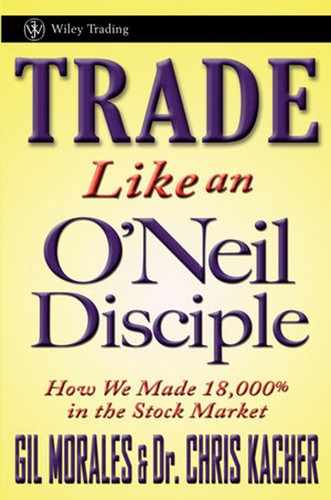1.4. CUTTING LOSSES QUICKLY
Jesse Livermore wrote in How to Trade in Stocks, "You should have a clear target where to sell if the market moves against you. And you must obey your rules! Never sustain a loss of more than 10 percent of your capital. Losses are twice as expensive to make up. I always established a stop before making a trade" (How to Trade in Stocks [Greenville: Traders Press, 1991], 171). O'Neil advises a 7 to 8 percent automatic stop-loss policy on all stock purchases, and the main reason for this is to keep oneself out of danger. Huge losses in the market can be debilitating, and O'Neil views a strict stop-loss policy, whether at his threshold of 6 to 7 percent or Livermore's 10 percent, as absolutely necessary for survival in the stock market. Livermore observed, "Taking the first small loss is wise...profits take care of themselves but losses never do" (1991, 7).
Richard Wyckoff in Stock Market Technique Number 1 advised: "Your first line of defense is a stop order—placed when you make the trade, or immediately thereafter. If you fail to limit your risk at inception, make a practice of looking over your commitments every day, or twice every week and selling out, at the market, all showing a loss. That will keep your sheet clean and allow your profitable trades to run until the time comes to close them out" (1933, 96). This concept of using a stop-loss as a "line of defense" runs parallel to O'Neil's thinking that "letting your losses run is the most serious mistake made by almost all investors" (How to Make Money in Stocks, 2nd ed. [New York: McGraw-Hill, 1995], 93) simply because "[i]f you don't sell to cut your losses when you get into trouble, you can easily lose the confidence you'll need to make buy and sell decisions in the future" (1995, 252). Not only do losses cut into the capital an investor has available to capitalize on potential opportunities in the stock market, they also take their toll on an investor's psychological capital, their all-important self-confidence.
To O'Neil, Livermore, and Wyckoff, losses are just part of the process, and it is always better to take a little pain now rather than a lot of pain later, because, as O'Neil reveals, "The whole secret to winning big in the stock market is not to be right all the time, but to lose the least amount possible when you're wrong" (1995, 240).
